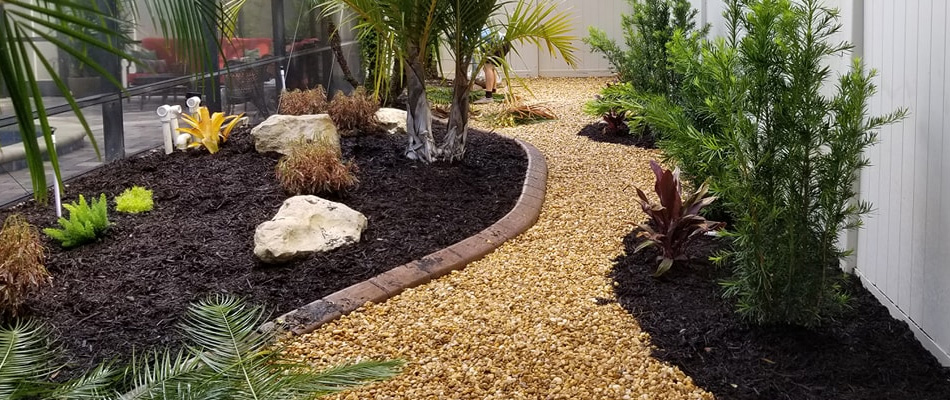Not known Details About Hilton Head Landscapes
The Definitive Guide for Hilton Head Landscapes
Table of ContentsThe Ultimate Guide To Hilton Head LandscapesGet This Report about Hilton Head LandscapesSome Ideas on Hilton Head Landscapes You Need To KnowNot known Factual Statements About Hilton Head Landscapes The Ultimate Guide To Hilton Head LandscapesThe 3-Minute Rule for Hilton Head LandscapesHilton Head Landscapes - Truths
Line creates all forms and patterns and can be used in a variety of ways in the landscape. Line in the landscape is developed by the edge in between two materials, the outline or silhouette of a form, or a lengthy direct function. Lines are a powerful device for the developer since they can be used to develop a limitless variety of shapes and forms, and they control activity of the eye and the body.

Lines can have several qualities, such as those explained listed below, however they commonly offer various purposes. Number 1. Lines in the landscape - Landscaping bluffton sc. The residential properties of lines determine how individuals reply to the landscape, both emotionally and literally. Straight lines are structural and forceful; they create a formal character, are usually related to a symmetrical style, and lead the eye straight to a focal point.
Hilton Head Landscapes Fundamentals Explained
Rounded lines create a casual, natural, kicked back character that is linked a lot more with nature and asymmetrical equilibrium. Curved lines move the eye at a slower rate and include secret to the room by developing concealed sights.
Upright lines in the landscape include tall, narrow plant material, such as trees, or tall structures, such as an arbor or a bird house on a pole. Horizontal lines move the eye along the ground aircraft and can make an area feel bigger. Reduced lines are a lot more subdued and create a feeling of remainder or repose.
The Facts About Hilton Head Landscapes Uncovered
Lines are additionally produced by the upright forms of constructed attributes and plant material. There are three primary line kinds that create kind in the landscape: bedlines, hardscape lines, and plant lines.
Bedlines attach plant product to your home and hardscape since the eye complies with the line, relocating the stare via the landscape. Hardscape lines are produced by the edge of the hardscape, which defines the built structure. Line can additionally be created by lengthy and slim products, such as a fencing or wall.
The 5-Second Trick For Hilton Head Landscapes
Kind is found in both hardscape and plants, and it is normally the leading visual aspect that spatially organizes the landscape and usually identifies the style of the garden. The type of frameworks, plant beds, and garden ornaments likewise identifies the general type style of the yard. Official, geometric types include circles, squares, and polygons.
Plants develop kind in the yard with their lays out or silhouettes, yet kind can additionally be specified by a space or negative room in between plants - Landscapers near me (https://www.openlearning.com/u/stevengonzales-sg0o4h/). Circles can be complete circles, or they can be separated right into half circles or circle sections and combined with lines to develop arcs and tangents
The Definitive Guide to Hilton Head Landscapes
Circles can additionally be extended into ovals and ellipses for more variety and interest. Circles are a solid style type due to the fact that the eye is constantly attracted to the center, which can be made use of to highlight a prime focus or link various other types. Figure 2. Round forms in hardscape and grass panels.
The square kind can also be segmented and pre-owned repeatedly to this hyperlink develop a grid pattern. Unlike circles, squares are stronger on the brink, which can be lined up or overlapped to develop special patterns and more complex kinds. Polygons are many-sided kinds with straight edges. Triangulars, as an example, are three-sided polygons.
Meandering lines typically resemble the natural program of rivers or streams and can be defined as smooth lines with deeply rounded wavinesses. Twisting lines (Number 3) work well for pathways, plant bedlines, and dry stream beds. Meandering lines can add rate of interest and secret to a yard by leading visitors around edges to uncover new views and rooms.
The 3-Minute Rule for Hilton Head Landscapes

Typical plant types are well established and standard, as type is the most regular and well-known attribute of plants. Kind can likewise be developed with the massing of plants, where the total mass creates a various form than a specific plant.
A very contrasting type needs to be utilized with careone or more job well as a focal factor, but way too many create chaos. All-natural plant forms, as opposed to over-trimmed types, ought to develop the bulk of the make-up. The importance of general form is basically depending on the seeing perspectivethe type of a tree can show up quite different to an individual standing under the cover versus watching the tree from a distance in an open area.
Hilton Head Landscapes for Beginners
Plant kinds also develop and define deep space or open rooms in between the plants, creating either convex or concave types in deep spaces. High-arching tree branches typically produce a concave open area under the branches, and a round cover with low branches fills the space to produce a convex type in the open space under the tree.
